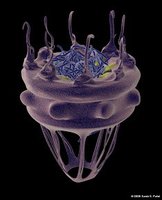DNA in our cells that carries our genetic information is sequestered in the cell nucleus, separated from the rest of the cell by an approximately 40 nm thick barrier known as the Nuclear Envelope. For proper cell functioning, molecular access to the DNA has be tightly regulated, and its dis-regulation results in a large number of diseases. This poses an extreme logistical and energetic problem for the cell: selectively and efficiently transporting millions of proteins and other molecules into and out the cell per second against their concentration gradients in the presence of vast amounts of molecular noise and fluctuations. All this enormous transport is maintained and regulated by biomolecular “nanomachines” known as the Nuclear Pore Complexes (NPC). NPC is a very large – largest in the cell - molecular assembly that contains several hundreds of copies of proteins of ~30 different types that form the scaffold, the “gears” and the “engine” of the machine. Remarkably, despite significant differences in the molecular details between different species, the physical transport mechanism appears to be universal – from yeast to humans – which makes it amenable to understanding from basic physical principles.
Due to the paucity of experimental methods capable to directly probe the internal morphology and the dynamics of NPCs, much of our knowledge about its properties derives from in vitro experiments interpreted through theoretical and computational modeling. In particular, many aspects of the NPC transport can be recapitulated in artificial nano-channel “mimicks” that inform the theoretical models and serve as prototypes for molecular sorting nano-devices for technological applications. In this talk, I will present the current understanding of the principles of the structural organization and function of the Nuclear Pore Complex and related man-made nano-devices, based on the analysis of in vitro and in vivo experimental data in light of minimal complexity models relying on the statistical physics of molecular assemblies on the nanoscale.


